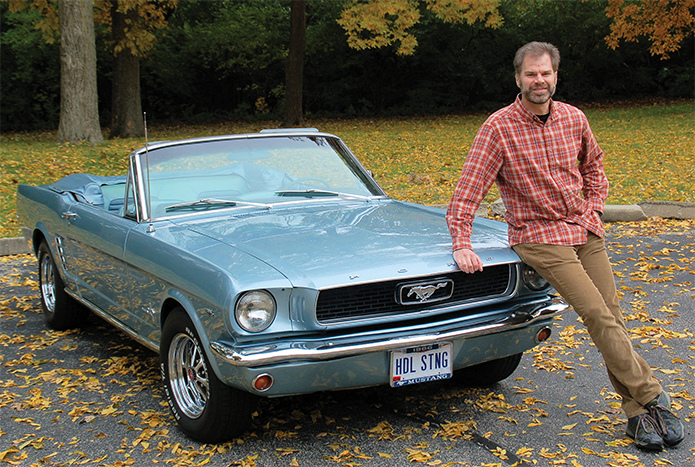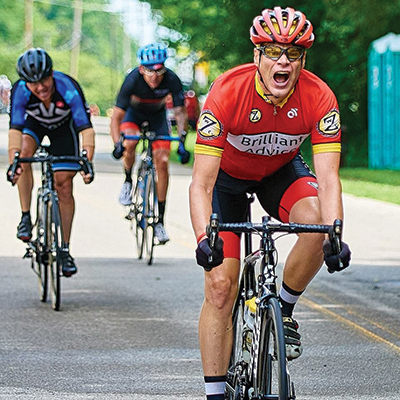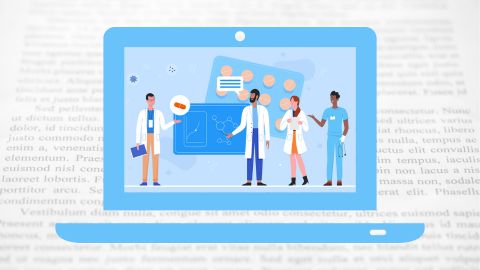Meet Sean Davidson
Sean Davidson is a confirmed Midwesterner.
“My entire career has been pretty much on the I-70 corridor,” said Davidson, a professor at the University of Cincinnati. “I’ve been across the highway but not more than an hour north or south of it.”
Davidson grew up and went to college in Indiana. After doctoral studies at Drexel University in Philadelphia and a postdoc at the University of Illinois Urbana–Champaign, he started as an assistant professor at the University of Cincinnati in 1998. Today, he leads the university’s division of experimental pathology, has won numerous excellence in teaching awards, and runs a research lab with physician-scientist Amy Shah.
The lab focuses on high-density lipoprotein particles, which to many people are synonymous with “good cholesterol.” But Davidson cringes at that term. To him, HDL is much more than a vessel for cholesterol transport; it’s a complex mixture of dozens of proteins and hundreds of lipids.
“If we can understand the different subparticles within the family of HDL,” he said, “we can impact biology that affects a lot of different disease states.”
ASBMB Today writer Laurel Oldach talked to Davidson, an associate editor of the Journal of Lipid Research, about his research into the composition of HDL particles and their roles in disease. The interview has been edited for length and clarity.

What draws you to studying high-density lipoproteins?
HDL has been a controversial area in the past couple of years. Epidemiological evidence suggests that HDL cholesterol levels in blood are a negative risk factor for cardiovascular disease. People thought for a long time that it promotes cholesterol efflux and removes cholesterol from the coronary arteries around the heart, helping to prevent cardiovascular disease. But there’s been a lot of evidence recently that drugs that can raise HDL cholesterol really high — which makes your doctors very happy — don’t translate to the protection you’d expect from the epidemiology. From that perspective, HDL is not popular to work on right now because the drugs that target HDL haven’t been that successful.
But I tend to look at HDL from a different viewpoint — as a platform that circulates in the plasma that allows different proteins to get together, dictating distinct functions. I don’t think HDL evolved to protect us from heart disease; I think it evolved as almost an extracellular version of a plasma membrane. A plasma membrane has a barrier function, but it also acts as a medium that allows proteins to find each other more easily than if they were diffusing randomly. HDL serves this function outside the cell — kind of a singles’ bar for circulating proteins.
Some of the proteins it assembles are involved in cardiovascular disease. That’s for sure. But many are involved in the immune response; some are involved in blood clotting and protease inhibition; some are even involved in metal and vitamin transport. It’s such a fascinating and complex platform for a lot of biology that we don’t fully understand.
Is HDL one thing? Or is it a lot of different things that behave similarly?
I don’t think there’s one type of HDL. I think there are probably upward of 50 different particles in a family that happen to spin out at the same density in an ultracentrifuge. If you put protein and lipid together, no matter what, they’re probably going to have about the density of HDL. In terms of its composition, there are about 100 different proteins that can be associated with HDL and hundreds of different lipid species.
I think the initial studies may have done us a disservice by thinking about HDL only in terms of its cholesterol composition rather than thinking of it as a constellation of different particles. We got onto cholesterol back in the old days because it was easy to measure, and it has just carried over.
Since different HDL particles have similar physical characteristics, it’s hard to tease them apart and figure out what they do individually. That’s what my lab is specializing in doing. We’re trying to find ways to separate HDL subspecies and figure out what they do and how that functionality may differ from other particles.
Technically, how do you approach analyzing HDL particles? It sounds like they all look similar in some ways.
HDL is a good example of the observer effect problem in science. It’s kind of like counting butterflies in a box. You have to open the box to count them, but opening the box causes you to lose some before you can get an accurate count. Similarly, you have to isolate HDL before you can study it, and how you isolate it can affect its composition and function.
We have taken the approach of using very gentle biochemical methods to get at these particles without putting them under harsh ionic strength conditions or high G-forces. We do a lot of chromatography to complement analytical approaches, and we have been working to come up with antibodies that can label very specific subspecies of HDL. The goal is to use those clinically to link certain subspecies to specific functions and eventually to different disease states.
Are there special challenges to raising an antibody against a lipoprotein?
ApoA-I, the major protein on HDL, exists in at least three different conformation states. It can be lipid-free; it can be bound in nascent, immature HDL particles; and it can be found in larger, spherical HDL particles. The immunoreactivity is different in each of those states.
And it’s so dynamic. I joke that apoA-I is like a piece of spaghetti that you take out of the pot and throw on the wall. However it lands, that’s the shape it is. That’s the major challenge.
Are all these different types of HDL particles pretty highly regulated? Is the variety of compositions uniform, or is HDL more of a random jumble?
In the studies that we’ve done, different people have clearly different subspecies patterns. I don’t think they’re randomly distributed. There’s definitely a method to the distribution; it’s just we don’t fully understand it.
I really hope that we can understand this heterogeneity and we can design drugs or therapies that skew the HDL particle populations toward the particles that are most beneficial for certain disease states.
(With current therapies) we raise HDL cholesterol in the general sense. Companies have invested billions of dollars in a class of drugs that target cholesterol ester transfer protein, which exchanges cholesterol and triglycerides between HDL and other lipo–proteins. If you shut that off, the HDL accumulates lots of cholesterol. And your doctor wants to see your HDL cholesterol levels as high as possible. So, from that standpoint, these drugs work great: They can raise HDL cholesterol levels upward of 100%.
But these are very large, abnormal HDL particles that we think either are dysfunctional themselves or have metabolically eliminated other HDL particles that are important. And unfortunately, these drugs haven’t been terribly successful in preventing cardiac outcomes. So indiscriminately raising HDL cholesterol across the board is probably not the way to go. We think it will be better to target certain subspecies that may be more connected with disease.
Besides heart disease, what other disease states might HDL be involved in?
Because a lot of these particles have different immune molecules, they could have a role in many disease states. For example, we’ve got a project now studying how different HDL subspecies might guard against sepsis in a mouse model.
The problem with sepsis is not necessarily the underlying infection. The clinical aspect that’s so damaging is the immune response that follows. The immune system hyper-responds, and that causes cytokine release and, eventually, organ damage. HDL is linked to anti-inflammatory effects, so we think that HDL is a natural target for calming the body’s immune response in the face of sepsis.
Stepping back a bit, how did you get into science? What made you decide on research?
I’ve always been pretty analytical, a geek, if you will. I was one of those annoying kids that took things apart and wanted to figure out why things worked. Both my parents were pharmacists, so I knew a bit about science from them. In high school, I thought about being an architect. But as soon as I got to college and took my first chemistry class, I said, “This is pretty cool stuff!” and just locked into it.
When you do a series of experiments, you learn something that nobody else knows and nobody in the history of mankind has ever known. That’s an amazing feeling.
I also enjoy training students in the laboratory and helping them on their careers. That’s been really fulfilling, along with the science.
I hear you’re a cyclist in your spare time. Is that a hobby where you get to take stuff apart and put it back together again a lot?

Yes, unfortunately. The three important things in my life are my family, science, and cycling — not necessarily in that order. I’ve been racing a bicycle since I was in high school, so pretty much all my spare time I’m riding my bike. I’ll usually go for a three- to five-hour ride on Saturday and the same on Sunday. I do a lot of road racing, and I was fortunate enough to win the Ohio state championship this year for road time trial among men in my age group.
It’s hard to remain competitive in cycling and still keep my lab running, but I think I’ve struck a good balance. Physical exercise and doing something you love like that are important to maintain a balance, because otherwise you’d go crazy.
And it’s important for creativity. Sometimes, I’ll be out for a long ride and I’ll zone out, and I’ll come back and hang up my bike in the garage and have designed a whole experiment in my head without thinking about it.
How did you become associated with the JLR?
It’s always been one of my favorite journals. I have a file folder filled with papers from different people, but the JLR ones always seem to be the most ragged. The important papers that I go back to are usually in JLR.
I can’t remember when my first JLR paper was — it must have been not long after I started my career. (JLR Associate Editor) Alan Attie invited me to join the editorial board soon after I became an assistant professor, and after three or four cycles, they invited me to be an associate editor.
Do you have any advice for young scientists?
My advice is to stick with it. I see a lot of kids who see how tough grant writing is and postdocs that last a lot longer than three to four years, and a lot of them chose to do something else. I hate to see that.
This is a tough business. You put your best work into a paper or a grant, and you send it out to people whose job it is to criticize it. That can be hard. But the rewards outweigh the setbacks, eventually. My advice is to get as broad an experience as possible in different laboratories, get with advisors who will help you come up with a project that will be yours, and just keep working at it.
Enjoy reading ASBMB Today?
Become a member to receive the print edition monthly and the digital edition weekly.
Learn moreGet the latest from ASBMB Today
Enter your email address, and we’ll send you a weekly email with recent articles, interviews and more.
Latest in People
People highlights or most popular articles

2024 voter guide
Learn about the candidates running for ASBMB Council, Nominating Committee, Publications Committee and treasurer.

Charles O. Rock (1949 – 2023)
Colleagues and trainees remember a world expert in membrane lipid homeostasis.

Honors for Clemons, Hatzios and Wiemer
Awards, honors, milestones and more. Find out what's happening in the lives of ASBMB members.

Touching the future from the bench
Scholar, scientist, teacher and mentor Odutayo Odunuga discusses the important roles of the institutional PI, his journey and his research.

In memoriam: Darwin Prockop
He held leadership positions at multiple institutions and was known for his contributions to adult stem cell biology and cellular biology.

A look into medical writing
Our careers columnist spoke with Ashlea A. Morgan at Chameleon Communications International to get a sense of one type of work a medical writer can do.

